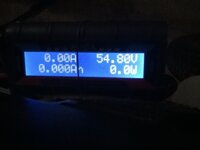Lightning P38
Active Member
Hi, I have a 36 volt battery that I have used for two years, from ebikekit.com . About 50 discharge cycles from 100% down to 50% or 60% typically. Today I topped off the battery, but this time it seemed it was taking longer than usual, and the charger was warm to the touch, so I checked the voltage with my voltmeter, and the battery was at 41.8 volts. The charger light was still red, so it was still charging. I was thinking it should reach 42 volts.
This is the first time I checked the voltage this year, because things have been humming along.
Am I seeing a slight reduction in battery capacity?
Is there anything I should be watching?
This is the first time I checked the voltage this year, because things have been humming along.
Am I seeing a slight reduction in battery capacity?
Is there anything I should be watching?
